A World of Avocados in Cuzco

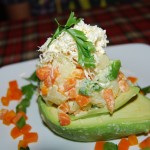
Good enough to be a meal in itself, a split avocado with a mound of fillings, finds itself on the appetizer (entradas) list on the menus of many restaurants in Cuzco. Whether filled with chicken salad (palta a la reina) or with diced vegetable / potato salad (palta a la jardinera)–or even other things like shrimp salad or tuna salad –it is a standard of Peruvian cuisine. And, it is delicious.
Otherwise, if we leave aside the use of avocados in sandwiches, it is as if the avocado disappeared from the mainstream of Peruvian gastronomy. Yet Peru is graced with being one of the birth places of the avocado and it has an unusual indigenous variety of avocados to exploit.
Though throughout the Spanish world “aguacate”, a word related to the English “avocado”, is used to describe this fruit scientists name “persea americana”, In Peru as in the parts of South America influenced by the Inca Empire a different word is used, “palta”.
The presence of this different word indicates that, although most writers argue the avocado is native to Central America or Mexico, it has an ancient Peruvian past as well.
Garcilaso Inca de laVega, the great Peruvian writer born shortly after the Spanish Invasion, included it in his list of fruits known to the Incas.

The fruit that the Spanish call “pears”, because they are reminiscent of the pears of Spain in their green color and shape, are called by the Indians “palta” because the were spread from a province of this same name. They are two of three times larger than the largest pears of Spain. They have a soft and thin skin under which is their flesh which might be a finger in width Inside they have a seed which is the same shape as the pear and as thick as the common pears of Spain. The fruit is very flavorful, very healthful for the sick. Eaten with sugar, it is a preserve that is in much demand
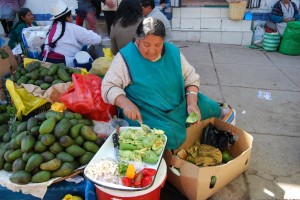
The word palta was the name of a group of people but it also took the reference of the ways in which those people deformed their “heads”. This contrasts with Mexico where the root word still found in our English “avocado”, the Nahuatl “ahuacatl” referred to a different body part, the testicles.
But the head held a particular fascination for Andean civilization, particularly the head of foreigners. It was potentially the source of new life and so the appropriation of avocados, as heads, by the Incas and other Andeans had meaning.
The province of Palta appears to have been in contemporary Ecuador, around the contemporary Saraguro. Thus many have argued the avocado spread from there into Peru.
But archeologists have found domesticated avocado seeds buried in tombs from the Peruvian north coast some 4000 years ago. It has been found in sites such as La Galgada, Las Haldas, and Los Gavilanes, according to Quilter and his fellows (p281). So, despite how neat the story of an Ecuadorian origin for Avocadoes is, it is not quite so cleanly supported in the archeological record.
And there are other mysteries. Smith (p. 258) argued we need to understand how these seeds relate to the three main “races” of avocados listed today, the Mexican, the Guatemalan, and the West Indian, since the study of avocados is based on the premise of an origin in Central America and then a spread southward.
If the avocado did originate in Central America and spread southward it must have spread very early indeed. By now representatives of all three kinds of avocados are found in Peru’s forests and markets, though the West Indian variety seems to predominate the non-industrial production. It is similar to the avocados of Florida rather than the Hass of California.
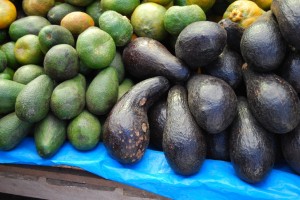
There also is a need to understand the variety of wild and cultivated avocados found in Peru. Going to markets in small towns, or visiting people’s homes outside the cities is fascinating because one can often find unusual varieties of avocado, each with their own flavor.
In the last sixteen years Peru has become a major grower and exporter of avocados. But these are not the indigenous ones.
Peru´s cities increasingly are dominated by the hybrid variety called Fuerte which is one of the main industrial agricultural avocados. Chances are this is the avocado that is the base of your stuffed avocado in a Cuzco restaurant. It is the major variety promoted within the formal networks of food distribution.
However Peru is also an exporter of the Hass which is almost the only avocado found in most American grocery stores. If it weren’t for the Florida avocado it would be the only one.
Nonetheless, Peru does not export avocados to the US market. Rather it exports them almost exclusively to Europe. Peru’s avocado harvest is in full swing and shipments of fresh Hass avocados are on the way to Europe, just as the tourist season kicks in and airplanes filled with tourists arrive from Europe.
Personally, I find the Hass avocado rather tasteless. It seems another food variety chosen by agroindustry for its picking, shipping, and storage qualities rather than for its culinary value. I prefer the Fuerte to the Hass, but even more I love to go into the markets and taste different avocados.
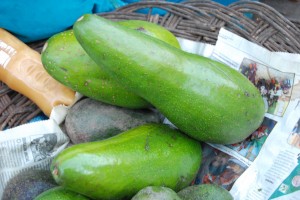
In San Pedro Market we bought a long fat avocado we were told was from Abancay that was about eight or nine inches in length. With a Swiss Army Knife we sliced it open and ate–no lemon, no salt. It was wonderful. It was of the West Indian macro-group, evidently, and so had a lighter texture than the Hass–less oily–but had built into it a kind of graininess and had chocolaty, meaty overtones. Needless to say, it soon disappeared and was a meal all by itself.
Peru contains a wide diversity of avocados that are underexploited by its food industry, unless one goes to people’s homes and eats. There, in Cusco’s regions, one finds a rich array of avocados, from small fingerlings, to softball sized round ones, and giant tear drop avocados, each with a different and often complex taste. They do not need much processing. Sliced and served they are a wonder.
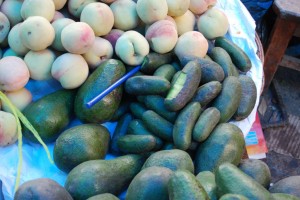
References cited:
Subsistence Economy of El Paraíso, an Early Peruvian Site Author(s): Jeffrey Quilter, Bernardino Ojeda E.,, Deborah M. Pearsall, Daniel H. Sandweiss, John G. Jones, Elizabeth S. Wing Source: Science, New Series, Vol. 251, No. 4991 (Jan. 18, 1991), pp. 277-283
The New World Centers of Origin of Cultivated Plants and the Archaeological Evidence Author(s): C. Earle Smith, Jr. Source: Economic Botany, Vol. 22, No. 3 (Jul. – Sep., 1968), pp. 253-266




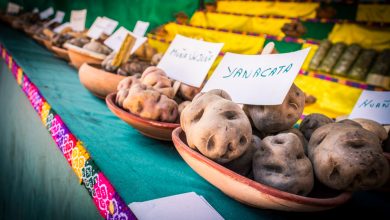
This was a truly remarkable read. How long have you been writing? I enjoyed this article so very much.
I had no idea that this blog would make me involved so easily